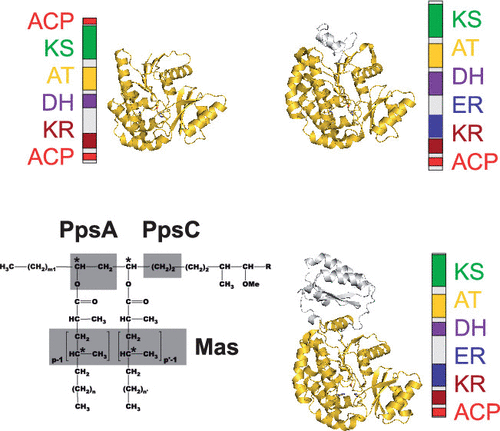当前位置:
X-MOL 学术
›
ACS Chem. Biol.
›
论文详情
Our official English website, www.x-mol.net, welcomes your
feedback! (Note: you will need to create a separate account there.)
Molecular Basis for Extender Unit Specificity of Mycobacterial Polyketide Synthases
ACS Chemical Biology ( IF 3.5 ) Pub Date : 2020-11-25 , DOI: 10.1021/acschembio.0c00772 Anna D Grabowska 1 , Yoann Brison 1 , Laurent Maveyraud 1 , Sabine Gavalda 1 , Alexandre Faille 1 , Virginie Nahoum 1 , Cécile Bon 1 , Christophe Guilhot 1 , Jean-Denis Pedelacq 1 , Christian Chalut 1 , Lionel Mourey 1
ACS Chemical Biology ( IF 3.5 ) Pub Date : 2020-11-25 , DOI: 10.1021/acschembio.0c00772 Anna D Grabowska 1 , Yoann Brison 1 , Laurent Maveyraud 1 , Sabine Gavalda 1 , Alexandre Faille 1 , Virginie Nahoum 1 , Cécile Bon 1 , Christophe Guilhot 1 , Jean-Denis Pedelacq 1 , Christian Chalut 1 , Lionel Mourey 1
Affiliation

|
Mycobacterium tuberculosis is the causative agent of the tuberculosis disease, which claims more human lives each year than any other bacterial pathogen. M. tuberculosis and other mycobacterial pathogens have developed a range of unique features that enhance their virulence and promote their survival in the human host. Among these features lies the particular cell envelope with high lipid content, which plays a substantial role in mycobacterial pathogenicity. Several envelope components of M. tuberculosis and other mycobacteria, e.g., mycolic acids, phthiocerol dimycocerosates, and phenolic glycolipids, belong to the “family” of polyketides, secondary metabolites synthesized by fascinating versatile enzymes–polyketide synthases. These megasynthases consist of multiple catalytic domains, among which the acyltransferase domain plays a key role in selecting and transferring the substrates required for polyketide extension. Here, we present three new crystal structures of acyltransferase domains of mycobacterial polyketide synthases and, for one of them, provide evidence for the identification of residues determining extender unit specificity. Unravelling the molecular basis for such specificity is of high importance considering the role played by extender units for the final structure of key mycobacterial components. This work provides major advances for the use of mycobacterial polyketide synthases as potential therapeutic targets and, more generally, contributes to the prediction and bioengineering of polyketide synthases with desired specificity.
中文翻译:

分枝杆菌聚酮化合物合酶的扩展单位特异性的分子基础。
结核分枝杆菌是结核病的病原体,与其他细菌病原体相比,结核病每年夺去更多的生命。结核分枝杆菌和其他分枝杆菌病原体已发展出一系列独特的功能,可增强其毒力并促进其在人类宿主中的存活。这些特征中包括具有高脂质含量的特定细胞包膜,其在分枝杆菌的致病性中起重要作用。结核分枝杆菌的几个包膜成分以及其他分枝杆菌,例如,分枝菌酸,二硫代木蜡酚酸和酚类糖脂,属于聚酮化合物的“家族”,聚酮化合物是通过吸引人的多功能酶-聚酮化合物合成酶而合成的次级代谢产物。这些大合酶由多个催化结构域组成,其中酰基转移酶结构域在选择和转移聚酮化合物延伸所需的底物中起关键作用。在这里,我们介绍分枝杆菌聚酮化合物合酶的酰基转移酶域的三个新的晶体结构,并为其中之一,为鉴定确定扩展单元特异性的残基提供证据。考虑到扩展单元对关键分枝杆菌组分的最终结构所起的作用,揭示这种特异性的分子基础非常重要。
更新日期:2020-12-18
中文翻译:

分枝杆菌聚酮化合物合酶的扩展单位特异性的分子基础。
结核分枝杆菌是结核病的病原体,与其他细菌病原体相比,结核病每年夺去更多的生命。结核分枝杆菌和其他分枝杆菌病原体已发展出一系列独特的功能,可增强其毒力并促进其在人类宿主中的存活。这些特征中包括具有高脂质含量的特定细胞包膜,其在分枝杆菌的致病性中起重要作用。结核分枝杆菌的几个包膜成分以及其他分枝杆菌,例如,分枝菌酸,二硫代木蜡酚酸和酚类糖脂,属于聚酮化合物的“家族”,聚酮化合物是通过吸引人的多功能酶-聚酮化合物合成酶而合成的次级代谢产物。这些大合酶由多个催化结构域组成,其中酰基转移酶结构域在选择和转移聚酮化合物延伸所需的底物中起关键作用。在这里,我们介绍分枝杆菌聚酮化合物合酶的酰基转移酶域的三个新的晶体结构,并为其中之一,为鉴定确定扩展单元特异性的残基提供证据。考虑到扩展单元对关键分枝杆菌组分的最终结构所起的作用,揭示这种特异性的分子基础非常重要。











































 京公网安备 11010802027423号
京公网安备 11010802027423号